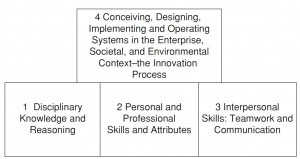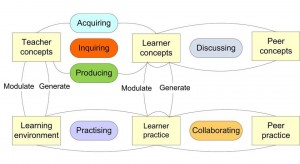Blog by Emiel van Puffelen (WUR)
Duikvaker 2017, a large Dutch diving exhibition held in February, featured a proud team of TU Delft students, who showcased their human-powered submarine (WASUB, 2017). Their design required a lot of courage to make, and even more to pilot. I noticed that these students were highly motivated. And they succeeded in making a complex and world record breaking design. Their success is not an exception. Other student teams from technical universities in Delft, Twente and Eindhoven won the last world solar challenge (first- and second prizes in Challenger Class, and first prize in Cruiser Class, respectively). These student teams created state-of-the-art designs. So, it would appear that their teachers has helped them by creating well designed engineering courses. But what is a well-designed course?
Figure 1: Four levels of ILO (CDIO 2014)
 Firstly, course design should be based on a well-constructed curriculum and properly formulated intended learning outcomes (ILOs). This is not easily attained. An option is to use the CDIO Approach (Crawley, Malmqvist, Östlund, Brodeur, & Edström, 2014), which should yield the four levels of ILOs shown in Figure 1.
Firstly, course design should be based on a well-constructed curriculum and properly formulated intended learning outcomes (ILOs). This is not easily attained. An option is to use the CDIO Approach (Crawley, Malmqvist, Östlund, Brodeur, & Edström, 2014), which should yield the four levels of ILOs shown in Figure 1.
There are many other approaches that usually yield ILOs on different levels, such as knowledge, skills and integration.
The ILOs are the starting point in creating Teaching and Learning Activity’s (TLAs), as well as Assessment. ILOs, TLAs and Assessment should be aligned (Biggs & Tang, 2011), as shown in this clip (Grob & Kotkamp, 2014).
The core of course design is selecting TLAs. That requires an open mind on how students learn and considering the use of each available type of TLA. Laurillard (2012, 2016) synthesised a list of TLAs from theories of learning:
Acquisition: reading, watching, listening.
Inquiry: using resources to develop an evidence-based output.
Discussion: debating, questioning, answering, negotiating ideas.
Practice: acting, in the light of feedback, to achieve a goal or output.
Collaboration: working with others to achieve a joint output.
Production: making something for others to evaluate against agreed criteria.
All types of TLAs can be seen in traditional campus education and they can also be supported online. In both cases, the processes shown in Figure 2 are supported.
Figure 2: TLAs and supported processes (based on Laurillard 2012, 2016)

Most Learning Management Systems (LMS) were developed to support the TLAs shown on the left side of Figure 2 (Acquiring, Inquiring, Producing and Practising) and sometimes they extend to those on the right side of Figure 2 (discussing and collaborating) in newer versions. However, a separate, specialised LMS might still be required for the best options with the TLAs on the right side.
Often, a large part of Figure 2 needs to be included in a course. One ILO might require different types of TLAs and the course set of ILOs might require more. In addition, a workflow of TLAs (such as reading, developing evidence-based output, debating) might be needed to reach an ILO, especially for engineering. Differences in learning styles and learning theories also point in the direction of combining different TLAs. Last, but not least, combining TLAs is necessary to engage students and keep them surprised!
A smart design of a combination of (many) types of TLAs is needed to create top-quality university courses.
Part of a smart design is the choice between on-campus and online versions of each TLA. Practical reasons (group size, available time, facilities, and curriculum standards) might dictate that choice. However, for engineering education there are limits in replacing on campus TLAs by online work. In general, the TLAs on the left side of the Figure 2 can be achieved with media resources (online, books etc). Most universities have a long tradition in this, and new developments, such as knowledge clips and Massive Open Online Courses (MOOCs), are creating more options. However, higher level engineering ILOs (above 1 CDIO) require rich on-campus collaboration work that cannot be completely offered online. Meet the TU Delft submarine students to find out why.
References
Biggs, J. B., & Tang, C. (2011). Teaching for Quality Learning at University (4th Revised edition ed.). Milton Keynes, United Kingdom: Open university press.
Crawley, E. F., Malmqvist, J., Östlund, S., Brodeur, D. R., & Edström, K. (2014). Rethinking Engineering Education; The CDIO Approach (2 ed.): Springer International Publishing.
Grob, M. A. G., & Kotkamp, E. (Writers). (2014). Constructive Alignment, TU Delft Beeldbank: Delft University of Technology.
Laurillard, D. (2012). Teaching as a design science: Building pedagogical patterns for learning and technology: Routledge Taylor & Francis Group.
Laurillard, D. (2016). Learning in the context of education; The conversational Framework. Presentation at the Online Educa Berlin 2016, Berlin. http://ignatiawebs.blogspot.nl/2016/12/limitless-learning-plenary-oeb16-on.html
WASUB. (2017). WASUB VII TU Delft Dream Team. Retrieved 7 februari 2017, from http://www.wasub.nl/
